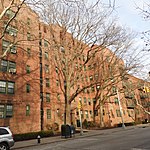St. Sebastian Roman Catholic Church (Queens)

St. Sebastian Roman Catholic Church is a Roman Catholic parish church in the Diocese of Brooklyn, located at Woodside, Queens, New York City. Although the parish of St. Sebastian itself was founded in May 1894 by Bishop Charles McDonnell of Brooklyn, New York, there was no building for the congregation until June 14, 1896 when the parish's first building was dedicated a year after the demise of its architect Franz J. Berlenbach, Jr.A new and permanent church building for the parish was later erected in 1952, on the location of a former cinema. Fr. Edward Gannon was the first pastor of the parish. The current church building is located on Roosevelt Avenue at 58th Street.
Excerpt from the Wikipedia article St. Sebastian Roman Catholic Church (Queens) (License: CC BY-SA 3.0, Authors, Images).St. Sebastian Roman Catholic Church (Queens)
58th Street, New York Queens
Geographical coordinates (GPS) Address External links Nearby Places Show on map
Geographical coordinates (GPS)
| Latitude | Longitude |
|---|---|
| N 40.744972222222 ° | E -73.906555555556 ° |
Address
Saint Sebastian's Roman Catholic Church
58th Street 39-66
11377 New York, Queens
New York, United States
Open on Google Maps











